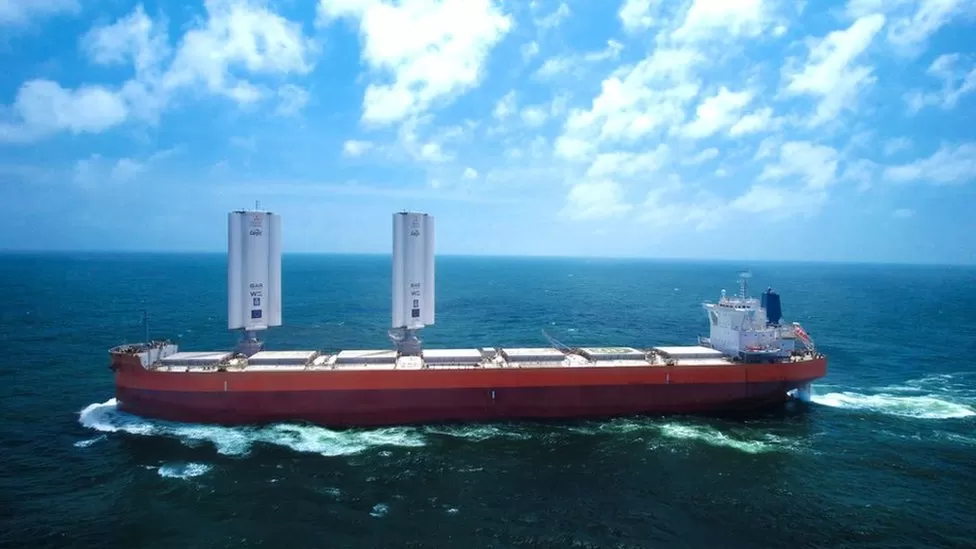Pioneering wind-powered cargo ship sets sail

Wind-powered sails fitted to a cargo ship have been set out on their maiden voyage.
Cargill, which has chartered the vessel, hopes the technology will help steer the industry towards becoming more environmentally friendly.
With WindWings sails, shipping’s carbon footprint can be reduced by cutting fuel consumption.
Carbon dioxide (CO2) emissions from the industry are estimated to be 2.1% of global emissions.
During the Pyxis Ocean’s first trip, the technology will be tested in the real world between China and Brazil.
When the ship is in port, they are folded down, but when it is at sea, they are opened. In order to make them durable, the towers stand 123 feet (37.5 meters) tall and are made of the same material as wind turbines.
It is possible to reduce a cargo ship’s lifetime emissions by 30% by allowing the vessel to be blown along by the wind instead of relying solely on its engine.
Jan Dieleman, president of Cargill Ocean transportation, said the industry was decarbonizing. This technology demonstrated how fast things were changing, although he admitted there was no silver bullet.
When asked about decarbonization five and six years ago, he told the BBC, “people in shipping said that it would be difficult, and it wouldn’t happen anytime soon.”
The narrative has changed completely five years later, and everyone is really convinced that they have to do their part – they’re just unsure how to get started.
That’s why we’re taking the role of one of the larger players to underwrite some of the risk, and try new things, and take the industry forward.”
Pyxis Ocean will reach its destination in approximately six weeks, but its technology is based on something much faster.
British company BAR Technologies developed the boat, which was spun out of the 2017 America’s Cup team led by Sir Ben Ainslie.
According to the BBC, this is one of the slowest-moving projects the company has ever undertaken, but it has the biggest impact on the planet.
The maritime industry will be transformed by this voyage, according to him.
By 2025, half of new ships will be propelled by wind, he predicts.
The reason I’m so confident is our fuel savings – one-and-a-half tonnes per day. With four wings on a vessel, that’s six tonnes of fuel saved, and that’s 20 tonnes of CO2 saved. The numbers are staggering.”
In spite of the fact that the wings themselves are manufactured in China, the innovation comes from the UK. Currently, Mr Cooper says the company cannot manufacture them here because the government does not support reducing the cost of imported steel.
According to the BBC, he would love to build in the UK.
‘Throw everything at it’
Wind power is a promising area of exploration for the shipping industry as it seeks to reduce its CO2 emissions.
A pledge made in July to reduce global warming gases to net-zero by 2050 was criticized as toothless by critics.
“Wind power can make a big difference,” says Dr Simon Bullock, a shipping researcher at the Tyndall Centre.
Since cleaner fuels won’t emerge for some time, he advised retrofitting existing ships with sails, kites, and rotors as part of operational measures.
It is imperative to make every voyage as efficient as possible until we have zero-carbon fuels on all ships. Slower speeds are also an important part of the solution, he said.
“Wind-related technologies are gaining some traction,” said Stephen Gordon, managing director of Clarksons Research.
According to him, the number of ships using this technology has doubled in the past year.
In the international shipping fleet and new-build order book of more than 110,000 vessels, we have records for fewer than a hundred having wind-assisted technology.”
In spite of this, wind technology may not be suitable for all vessels, for example when the sails interfere with container unloading.
According to Mr Gordon, the shipping industry does not yet have a clear decarbonisation pathway and there is unlikely to be a single solution to the problem in the near future or in the medium term.
The future of wind wings, according to John Cooper of BAR Technologies, is “very rosy.”
He also admits that he feels a sense of satisfaction when the industry returns to its roots.
“The engineers hate it, but I say it’s like going back in time.” he said.
We’re going to try to reverse that trend, just a little bit, thanks to the invention of big combustion engines that destroyed trade routes and sailing routes.
